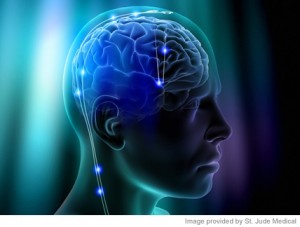 Patients with advanced Parkinson disease (PD) who received deep brain stimulation treatment had more improvement in movement skills and quality of life after six months than patients who received other medical therapy, but also had a higher risk of a serious adverse events, according to a study in the January 7 issue of JAMA.
Patients with advanced Parkinson disease (PD) who received deep brain stimulation treatment had more improvement in movement skills and quality of life after six months than patients who received other medical therapy, but also had a higher risk of a serious adverse events, according to a study in the January 7 issue of JAMA.
Deep brain stimulation is a surgical treatment involving the implantation of electrodes that send electrical stimulation to specific parts of the brain to reduce involuntary movements and tremors. It is the surgical intervention of choice when PD motor (movement) complications are inadequately managed with medications, according to background information in the article. “However, recent reports highlighting unexpected behavioral effects of stimulation suggest that deep brain stimulation, while improving motor function, may have other less desirable consequences,” the authors write. They add that there are few randomized trials comparing treatments, and most studies exclude older patients.
Frances M. Weaver, Ph.D., of Hines VA Hospital, Hines, Ill., and colleagues conducted a randomized trial to compare the benefits and risks of deep brain stimulation with those of best medical therapy for patients, of a wide age range, with PD. A total of 255 patients with PD were enrolled; 25 percent were age 70 years or older. The participants were randomized to receive bilateral deep brain stimulation with leads of the stimulation device implanted in the following locations of the brain: subthalamic nucleus (n = 60) or globus pallidus (n = 61); or received best medical therapy (n = 134), which included management by movement disorder neurologists, who monitored medication use and nonpharmacological therapy (e.g., physical, occupational, and speech therapy).
The researchers found that at 6 months, deep brain stimulation patients gained an average of 4.6 hours per day of on time (the time of good symptom control or unimpeded motor function) without troubling dyskinesia (involuntary movements), while the average change for the best medical therapy group was 0 hours. Motor function improved significantly with deep brain stimulation compared with best medical therapy, with 71 percent of deep brain stimulation patients vs. 32 percent of best medical therapy patients experiencing clinically meaningful motor function improvements at 6 months, while 3 percent of deep brain stimulation patients and 21 percent of best medical therapy patients had clinically worsening scores.
Compared with patients in the best medical therapy group, patients in the deep brain stimulation group experienced significant improvements in the summary measure of quality of life and on 7 of 8 PD quality-of-life scores. Neurocognitive testing revealed small decrements in some areas of information processing for patients receiving deep brain stimulation vs. best medical therapy.
The overall risk of experiencing a serious adverse event was 3.8 times higher in deep brain stimulation patients than in best medical therapy patients. Forty-nine deep brain stimulation patients (40 percent) experienced 82 serious adverse events. Fifteen best medical therapy patients (11 percent) experienced 19 serious adverse events. The most common serious adverse event was surgical site infection, with other serious adverse events including nervous system disorders, psychiatric disorders, device-related complications and cardiac disorders.
“The clinical significance of the adverse events and minor neurocognitive changes observed in patients in the deep brain stimulation group and, more importantly, whether patients who undergo deep brain stimulation view improvement in motor function and quality of life as outweighing adverse events, remain to be explored. More detailed analyses of adverse events and neurocognitive functioning following the conclusion of phase 2 of this study will shed light on these issues. Caution should be exercised, however, against overstating or understating the risks of deep brain stimulation for patients with PD. Physicians must continue to weigh the potential short-term and long-term risks with the benefits of deep brain stimulation in each patient,” the authors conclude.
In an accompanying editorial, Günther Deuschl, M.D., Ph.D., of the Universitätsklinikum Schleswig-Holstein, Kiel, Germany, comments on the findings of Weaver and colleagues.
“Although deep brain stimulation is the most important innovation for treatment of advanced PD since the discovery of levodopa [drug used to treat PD], many questions are still unanswered. For instance, the optimal timing for the implantation is unknown. The majority of patients undergo deep brain stimulation surgery more than 10 years after disease onset when the patients are already incapable of working and when the disease-related psychosocial decline has already begun. As quality of life is improved with this treatment it may improve psychosocial functioning in general for these advanced stages. With the aging of the general population, PD will become even more common and patients with PD will get older. Therefore, the present results showing similar efficacy and tolerability of deep brain stimulation in younger and older patients must be replicated because it is at variance with some other reports demonstrating lower rates of operative and postoperative complications in younger patients.
“Overall the results of this important study by Weaver et al have convincingly confirmed the 6-month efficacy of deep brain stimulation for advanced PD in the largest patient group studied thus far. However, this study, along with previous research on this therapy, shows that such progress cannot be made without costs in terms of adverse effects.”
